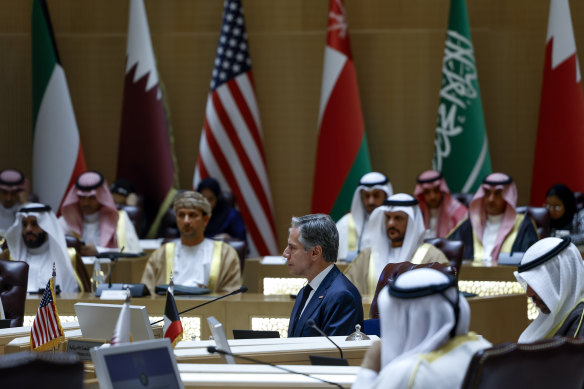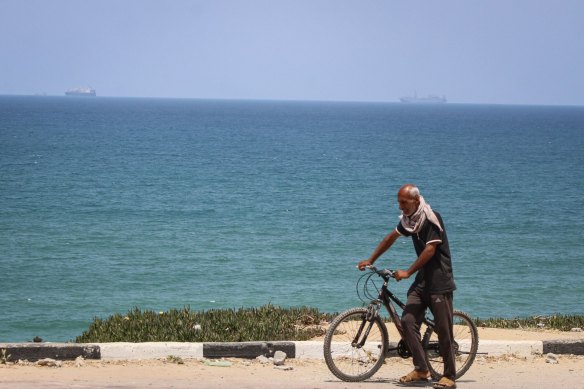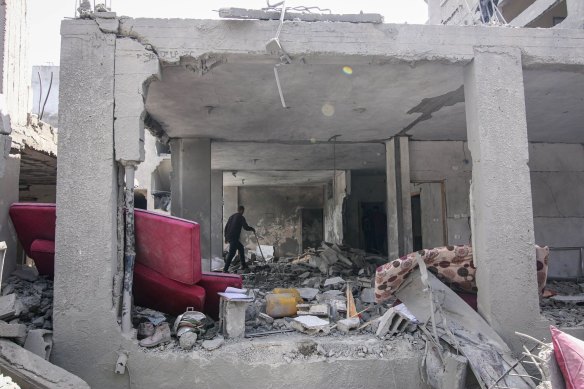This was published 11 months ago
Hope rises for new Gaza ceasefire talks as Israel scales back demands
By Patrick Kingsley, Edward Wong, Adam Rasgon and Eric Nagourney
Jerusalem: Israeli negotiators, offering a hint of hope for negotiations over a ceasefire in the Gaza Strip, have reduced the number of hostages they want Hamas to release during the first phase of a truce, three Israeli officials said on Monday.
For weeks, ceasefire talks have been at a standstill. With the new proposal in hand, a mid-ranking delegation from Israel was planning to fly to Cairo on Tuesday to resume them — but only if Hamas agreed to attend, according to two of the officials. They spoke on the condition of anonymity to discuss the sensitive issue.

US Secretary of State Antony Blinken, centre, and other officials discuss the humanitarian crises faced in Gaza, in Riyadh, Saudi Arabia.Credit: AP
Hamas did not respond to a request for comment about whether it would send representatives to Cairo. A senior Hamas official said on social media the group was studying a new Israeli proposal.
US Secretary of State Antony Blinken, who was meeting Arab diplomats in Saudi Arabia on Monday , said the onus was now on Hamas.
“Hamas has before it a proposal that is extraordinarily generous on the part of Israel,” Blinken said at an economic forum in Riyadh. “And at the moment, the only thing standing between the people of Gaza and a ceasefire is Hamas.”
Speaking at the same forum, British Foreign Minister David Cameron said the offer included a sustained 40-day ceasefire and the release of potentially thousands of Palestinians imprisoned in Israel in exchange for the hostages being held by Hamas.

The US Navy ship MV Roy P. Benavidez (right) and other vessels off the coast of Central Gaza on Sunday.Credit: Bloomberg
Egyptian Foreign Minister Sameh Shoukry said he was hopeful about the latest ceasefire offer, though he did not say what it involved or who had made it.
Seeking to increase the pressure on Hamas leaders to accept the deal, US President Joe Biden planned to speak to the leaders of Egypt and Qatar.
But other serious obstacles may remain, among them Hamas’ demand for a permanent ceasefire and Israel’s insistence on pursuing its goal of rooting out the militants, including in their last bastion in the southern city of Rafah.
And there was also concern that ceasefire talks might be disrupted if the International Criminal Court issues arrest warrants for senior Israeli government officials on charges related to the conflict with Hamas, as Israeli and foreign officials believe is in the works. The warrants may also name Hamas officials.
Hamas and its allies captured about 240 Israelis and foreigners in the deadly October 7 attack that set off the war. During a weeklong ceasefire in November, Hamas released 105 captives in exchange for 240 Palestinians being held in Israeli prisons.
In recent months, Israel has been demanding that Hamas release at least 40 more hostages – women, older people and those who are seriously ill – to secure a new truce. Now it was prepared to settle for only 33, the Israeli officials said.
The shift was prompted partly by the fact Israel now believes that some of the 40 have died in captivity, according to one of the officials.
Even as expectations rose that Hamas and Israeli negotiators might be edging closer to their first truce since the November ceasefire, their fighters were pressing on.

A Palestinian man in the remains of a destroyed building following an Israeli airstrike in a residential neighbourhood at the Nuseirat refugee camp in central Gaza on Saturday.Credit: Bloomberg
In Gaza, Israeli airstrikes flattened concrete buildings overnight, according to news agencies, which published video of rows of body bags. The Reuters news agency said the strikes had killed 20 people.
The Israeli military issued a statement saying that its “fighter jets struck terror targets where terrorists were operating within a civilian area in southern Gaza”.
More than 1 million Palestinians have crowded into shelters and tents in Rafah to seek safety from Israel’s military offensive.
One survivor, carrying a baby she said had been pulled from the rubble, told a Reuters video journalist that the child appeared to be uninjured, but that her parents had been killed.
“Look at us with some compassion, with some humanity,” said the woman, Umm Fayez Abu Taha. “This is all we ask for. We’re not asking for much: just end the war, nothing more.”
In northern Israel, a salvo of Hamas rockets came over the border from Lebanon. The Qassam Brigades, Hamas’ military wing, said in a statement that it had targeted an Israeli military position in Kiryat Shmona, the largest city in Israel’s far north, with a “concentrated rocket barrage.”
Though Hamas is based in Gaza, many of its leaders live in exile in Lebanon, where the group has a sizable presence. Since the war began, Hamas has occasionally launched rocket attacks into northern Israel from there, though its ally Hezbollah, the Lebanese militant group, has launched far more. Both groups are backed by Iran.
The rocket barrage on Monday, which was reported to have done little damage, was probably an attempt by Hamas to signal it was “still part of the fight”, said Mohanad Hage Ali, a Beirut-based fellow with the Carnegie Middle East Centre.
After arriving in Riyadh shortly after dawn, Blinken met the Saudi foreign minister, Prince Faisal bin Farhan, and then with foreign ministers and top foreign policy advisers from five other Arab nations. Blinken spoke with them about the war and the challenges it had created, from getting humanitarian aid into Gaza to freeing the hostages.
The American secretary of state and the Saudi foreign minister also talked about greater regional integration and “a pathway to a Palestinian state with security guarantees for Israel”, the State Department summary said. Later in the day, Blinken met with Crown Prince Mohammed bin Salman, the de facto leader of Saudi Arabia, and then attended a working dinner with officials from five Arab and five European nations to discuss the war. He planned to travel to Jordan and Israel on Tuesday.
In its best-case scenario, the Biden administration envisions Saudi Arabia and perhaps a few other Arab nations agreeing to normalise diplomatic relations with Israel. In exchange, Saudi Arabia would receive advanced weapons and security guarantees, including a mutual defence treaty, from the US and a commitment for US co-operation on a civilian nuclear program in the kingdom.
For its part, Israel would have to commit to a concrete pathway to the founding of a Palestinian nation, with specific deadlines, American and Saudi officials say.
At the economic forum in Saudi Arabia, Cameron said that something else must happen for the conflict to end: “The people responsible for October 7, the Hamas leadership, would have to leave Gaza.”
This article originally appeared in The New York Times.